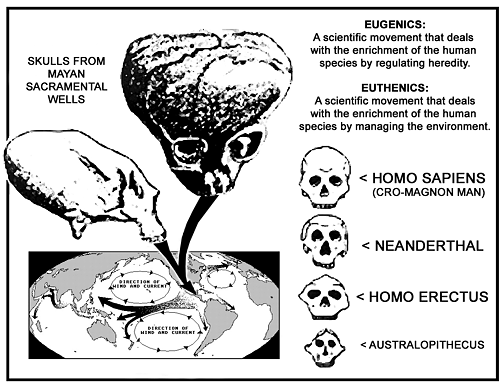spiritofatlantis.com | Duane K. McCullough

The Origins of Modern Man and the Scientific Timeline.
The idea that all humans of today evolved from one type of primate animal has resulted in much speculative literature.
As to where and when the first primate became "human", most paleontologist agree that the primate species of Neanderthal from
Afro-Eurasia was superceeded by Cro-Magnon Man some 35,000 to 40,000 years ago. Basically, the larger the brain cavity design,
the more recent the skull specimen. While the term "Homo Sapiens" is also used to describe Cro-Magnon Man, the newer
term of "Homo-Sapiens Sapiens" refer to Modern Cro-Magnon Man of the Neolithic Age.
V3
Chapter 3: The Cro-Magnon Crusade
1/ The science of anthropology has for several centuries
painted the perspective that modern human beings evolved in the
Old World and migrated to the New World, however if we examine
the definition of what anatomical features represent "modern
man" from "non-modern man", a simple geography
lesson will reveal that because the bones of Neanderthal Man - or
"non-modern man" are not to found anywhere in the New
World, then Cro-Magnon Man - or "modern man", may have
evolved in the New World and migrated to the Old World.
(According to modern paleontology, Cro-Magnon Man - named after
the cave in France where the first skeletal remains were found,
"superceded" Neanderthal Man approximately thirty-five
thousand years ago when he evolved a larger brain-cavity capacity
that provided more space for "hygienic memory habits",
resulting in "outlasting" the health and life of
Neanderthal Man)
[The anatomy of Cro-Magnon Man represents the same anatomy found
in every living human being today, thus we are all the latest
"matrix" of human evolution]

The origins of Homo Sapeins in the New World.
Since the word "sapient" is identified with the term "possessing the wisdom of planning for the future", and
because the Neanderthal stage of early man did not farm or construct a wide range of useful tools, Cro-Magnon Man of the
upper Paleolithic Age should be considered the first "Homo Sapiens".
2/ Moreover, recent archeological excavations in Middle America have
revealed from certain sacramental wells, skulls of young children with
extremely long heads shaped by "skull boards", whereby an ancient
"eugenics program" may have been practiced by early man
which could have contributed to the "controlled
evolution" of modern Cro-Magnon Man.
3/ Many encyclopedias describe a prehistoric culture of the
Upper Paleolithic period known as the Aurignacian, whereby
Cro-Magnon Man of western Europe developed the first true
examples of innovative cave paintings which required the
unprecedented mental ability of memorizing events in great
detail.
4/ Could this prehistoric Aurignacian culture be the same
antediluvian maritime society that created all those many
megalithic works throughout the north Atlantic?
5/ If so, then we should reexamine the archeological terms
that have defined the ages of man and study how the working of
metal by man has created certain time zones which are used to
measure human achievements.
Return to the Volume 3

